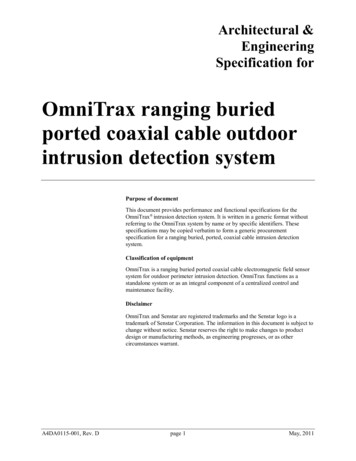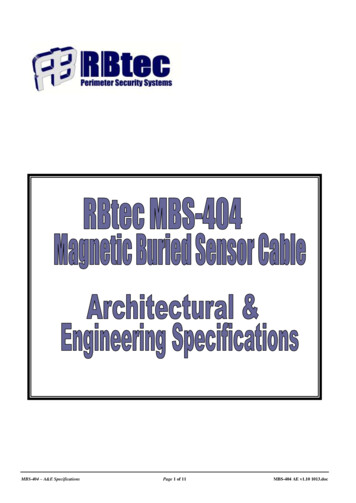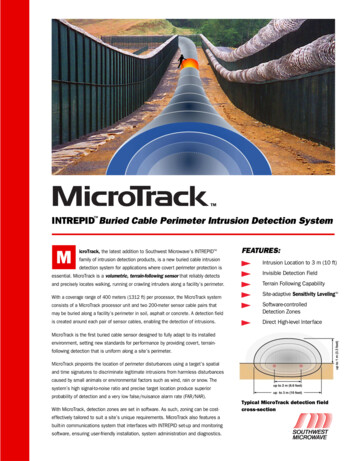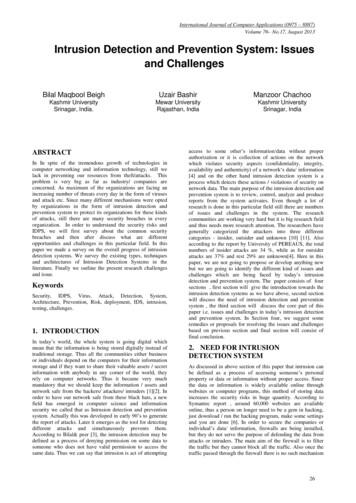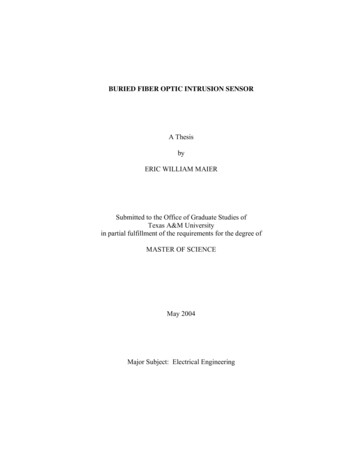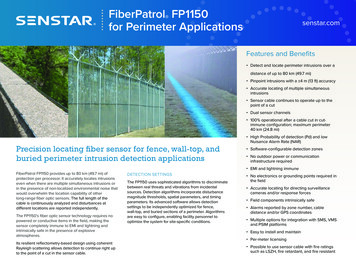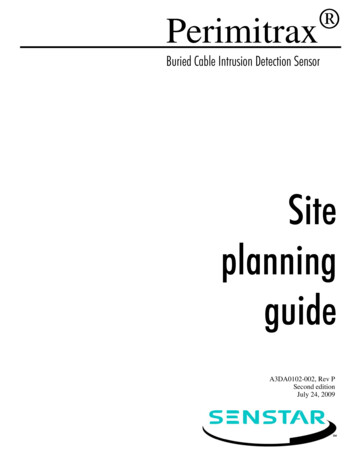
Transcription
PerimitraxBuried Cable Intrusion Detection SensorSiteplanningguideA3DA0102-002, Rev PSecond editionJuly 24, 2009
Senstar Corporation119 John Cavanaugh DriveCarp, OntarioCanada K0A 1L0Tel: 1 (613)-839-5572Fax: 1 (613)-839-5830Website: www.senstar.comEmail address: info@senstar.comA3DA0102-002, Rev P, Second EditionPerimitrax, Senstar and Sennet are registered trademarks, and Intelli-FLEX, Sentient and the Senstar logo are trademarks ofSenstar Corporation. Other Product names and Company names included in this document are used only for identificationpurposes and are the property of, and may be trademarks of, their respective owners.Copyright 2009, 2003, 2002, 2001, 2000, 1999, 1998, 1997 Senstar Corporation. All rights reserved. Printed in Canada.The information provided in this guide has been prepared by Senstar Corporation to the best of its ability. Senstar Corporation isnot responsible for any damage or accidents that may occur due to errors or omissions in this guide. Senstar Corporation is notliable for any damages, or incidental consequences, arising from the use of, or the inability to use, the software and equipmentdescribed in this guide. Senstar Corporation is not responsible for any damage or accidents that may occur due to informationabout items of equipment or components manufactured by other companies. Features and specifications are subject to changewithout notice.PatentsCanada no.: 1332185, 2202117, 2204485U.K. no.: 2318689Patents also issued or pending in other countries.U.S. no.: 5834688ApprovalsCanada: Sensor Module model SM100-1, SM100-2 and SMDT01Industry Canada Certification Number: CAN 1454 102 239Operation is subject to the following two conditions: (1) this device may not cause interference, and (2) this device must accept any interferenceincluding interference that may cause undesired operation of the device.This class B digital apparatus meets all requirements of the Canadian Interference - Causing Equipment Regulations.Cet appareil numérique de la classe B respecte toutes les exigences du Règlement sur le matériel brouilleur du Canada.This device conforms to CSA standard C22.2 no. 950.USA: Sensor Module model SM100-1, SM100-2 and SMDT01FCC Identification Number: I5T-BCIDS001This device complies with part 15 of the FCC Rules. Operation is subject to the following two conditions: (1) This device may not cause harmfulinterference, and (2) this device must accept any interference received, including interference that may cause undesired operation.Any changes or modifications not expressly approved by Senstar Corporation could void the user’s authority to operate the equipment.NOTE: This equipment has been tested and found to comply with the limits for a Class B digital device, pursuant to part 15 of the FCC Rules.These limits are designed to provide reasonable protection against harmful interference in a residential installation. This equipment generates,uses and can radiate radio frequency energy and, if not installed and used in accordance with the instructions, may cause harmful interference toradio communications. However, there is no guarantee that interference will not occur in a particular installation. If this equipment does causeharmful interference to radio or television reception, which can be determined by turning off and on, the user is encouraged to try to correct theinterference by one or more of the following measures:- Reorient or relocate the receiving antenna.- Increase the separation distance between the equipment and the receiver.- Connect the equipment into a outlet on a circuit different from that to which the receiver is connected.- Consult the dealer or an experienced radio/TV technician for help.This device conforms to UL standard 1950.Europe: Sensor Module models SM100-1, SM100-2 and SMDT01This device complies with EN50081-1, EN50130-4 and EN60950 A1 A2 standards as outlined in council directives 89/336/EEC and 73/23/EEC on the approximation of the laws of member states relating to Electromagnetic compatibility and low voltage directive, as amended bydirective 93/68/EEC.Radiocommunication Agency Certificate of type approval # 13657Radiocommunication Agency Certificate of EC type Examination of Electromagnetic compatibility # 13658Unit marked with CE and CEPT SRD 1dGBSenstar Corporation’s Quality Management System is ISO 9001:2000 registered.
Related publicationsPerimitrax Installation guide (A3DA0202):Provides instructions for installing the Perimitrax system and systemcomponents.Sennet product guide (M0DA0302):Describes Sennet system features and provides system planning, installationand setup guidelines.Intelli-FLEX product guide (multiplex version) (C6DA0402):Describes Intelli-FLEX multiplex version features, operation, components andapplications. It also provides instructions for planning, installing and settingup an Intelli-FLEX multiplex version system.Service statement - We ensure that our products are correctly applied to achieve the maximum benefits for the end-user. Wework hand-in-hand with our customers and remain accessible through all stages of a project - from concept to deployment tolong-term support. We provide design assistance, site surveys, installation support, comprehensive documentation, training,post-installation annual calibration and maintenance visits, electronics and software extended warranty, rapid factory repairservice and on-call/emergency service. Contact Senstar to inquire about how a package can be customized for your uniqueapplications.
Using this guideThis guide provides the information necessary to design a Perimitrax securitysystem.Chapters 1 and 2 are brief introductions to perimeter security as it relates toPerimitrax and some of the applicable scenarios for its use as a detection system;chapter 3 provides an overview of the steps involved in implementing a Perimitraxsystem; chapters 4 and 5 provide detailed explanations of the system and itsvarious components; chapter 6 describes site analysis information and chapter 7details the information required to adequately design your Perimitrax system. Theappendices provide sample configurations, system component orderinginformation and component specifications.FiguresThe figures contained in this document are for illustration purposes only, theymay differ from the actual equipment.Throughout this guide the illustrations show the SC1 sensor cable layout, unlessotherwise stated. SC2 sensor cable layouts are similar to the SC1 layouts with theexception that the SC2 systems use 2 cables instead of 1.AbbreviationsThe following abbreviations are used throughout this guide: CCTV - closed circuit television FAR/NAR - false alarm rate/nuisance alarm rate LTU - Sennet Large Transponder Unit NC - Sennet Network Controller n.c. - normally closed n.o. - normally open Pd - probability of detection RF - radio-frequency SC - sensor cable SM - Perimitrax Sensor Module TU - Sennet Transponder Unit
Table of contents1 Perimeter securityPerimeter security overview- - - - - - - - - - - - - - - - - - - - - - - - - - - - - - - - - - - - - - - - - - - - - - 1-12 ApplicationsPossible applications - - - - - - - - - - - - - - - - - - - - - - - - - - - - - - - - - - - - - - - - - - - - - - - - - - 2-13 Planning and installation overviewThe purpose of this guide - - - - - - - - - - - - - - - - - - - - - - - - - - - - - - - - - - - - - - - - - - - - - - - 3-14 System overviewIntroduction - - - - - - - - - - - - - - - - - - - - - - - - - - - - - - - - - - - - - - - - - - - - - - - - - - - - - - - Sensor cables - - - - - - - - - - - - - - - - - - - - - - - - - - - - - - - - - - - - - - - - - - - - - - - - - - - - - - Detection field - - - - - - - - - - - - - - - - - - - - - - - - - - - - - - - - - - - - - - - - - - - - - - - - - - - - - System configurations - - - - - - - - - - - - - - - - - - - - - - - - - - - - - - - - - - - - - - - - - - - - - - - - -4-14-24-44-55 System componentsIntroduction - - - - - - - - - - - - - - - - - - - - - - - - - - - - - - - - - - - - - - - - - - - - - - - - - - - - - - - - 5-1Sensor Modules - - - - - - - - - - - - - - - - - - - - - - - - - - - - - - - - - - - - - - - - - - - - - - - - - - - - - 5-2Enclosures - - - - - - - - - - - - - - - - - - - - - - - - - - - - - - - - - - - - - - - - - - - - - - - - - - - - - - - - - 5-6Sensor cable sets- - - - - - - - - - - - - - - - - - - - - - - - - - - - - - - - - - - - - - - - - - - - - - - - - - - - - 5-8Decouplers- - - - - - - - - - - - - - - - - - - - - - - - - - - - - - - - - - - - - - - - - - - - - - - - - - - - - - - - 5-14Cable Terminators - - - - - - - - - - - - - - - - - - - - - - - - - - - - - - - - - - - - - - - - - - - - - - - - - - - 5-16Power supply - - - - - - - - - - - - - - - - - - - - - - - - - - - - - - - - - - - - - - - - - - - - - - - - - - - - - - 5-17Local interface assembly - - - - - - - - - - - - - - - - - - - - - - - - - - - - - - - - - - - - - - - - - - - - - - - 5-20Network controller - - - - - - - - - - - - - - - - - - - - - - - - - - - - - - - - - - - - - - - - - - - - - - - - - - 5-21Sentient Security Management System- - - - - - - - - - - - - - - - - - - - - - - - - - - - - - - - - - - - - - 5-22Printer - - - - - - - - - - - - - - - - - - - - - - - - - - - - - - - - - - - - - - - - - - - - - - - - - - - - - - - - - - 5-24Repeater - - - - - - - - - - - - - - - - - - - - - - - - - - - - - - - - - - - - - - - - - - - - - - - - - - - - - - - - - 5-25Intelli-FLEX Multiplex version processor - - - - - - - - - - - - - - - - - - - - - - - - - - - - - - - - - - - 5-26site planning guide toc - 1
table of contents6 Site analysisIntroduction - - - - - - - - - - - - - - - - - - - - - - - - - - - - - - - - - - - - - - - - - - - - - - - - - - - - - - - Checklist - Site analysis - - - - - - - - - - - - - - - - - - - - - - - - - - - - - - - - - - - - - - - - - - - - - - - Site records - - - - - - - - - - - - - - - - - - - - - - - - - - - - - - - - - - - - - - - - - - - - - - - - - - - - - - - Installation medium - - - - - - - - - - - - - - - - - - - - - - - - - - - - - - - - - - - - - - - - - - - - - - - - - Obstacles- - - - - - - - - - - - - - - - - - - - - - - - - - - - - - - - - - - - - - - - - - - - - - - - - - - - - - - - - -6-16-26-36-56-77 System designChecklist - system design- - - - - - - - - - - - - - - - - - - - - - - - - - - - - - - - - - - - - - - - - - - - - - - - 7-2Installation mediums - - - - - - - - - - - - - - - - - - - - - - - - - - - - - - - - - - - - - - - - - - - - - - - - - - 7-3Obstacles- - - - - - - - - - - - - - - - - - - - - - - - - - - - - - - - - - - - - - - - - - - - - - - - - - - - - - - - - - 7-7System powering and data communication - - - - - - - - - - - - - - - - - - - - - - - - - - - - - - - - - - - 7-16Perimeter layout - - - - - - - - - - - - - - - - - - - - - - - - - - - - - - - - - - - - - - - - - - - - - - - - - - - - 7-23Equipment location - - - - - - - - - - - - - - - - - - - - - - - - - - - - - - - - - - - - - - - - - - - - - - - - - - 7-35Drawings- - - - - - - - - - - - - - - - - - - - - - - - - - - - - - - - - - - - - - - - - - - - - - - - - - - - - - - - - 7-37Residential and commercial applications - - - - - - - - - - - - - - - - - - - - - - - - - - - - - - - - - - - - 7-38a SamplesSample installations - - - - - - - - - - - - - - - - - - - - - - - - - - - - - - - - - - - - - - - - - - - - - - - - - - a-1Sample site drawings- - - - - - - - - - - - - - - - - - - - - - - - - - - - - - - - - - - - - - - - - - - - - - - - - - a-6b System component listc SpecificationsGlossaryIndextoc - 2 site planning guide
1Perimeter securityPerimeter security overviewEnhance your total securityProviding an effective security system for most facilities usually requires acombination of intrusion detection sensors. In many cases, the use of outdoorperimeter intrusion detection sensors will greatly enhance your total security.Interior security sensors that detect intruders at your front door or inside yourbuilding can be very effective. However, in many high security applications it maybe more advantageous to detect intruders at the perimeter before they enter yourbuilding, or in case of correctional facilities, before an inmate escapes.Outdoor perimeter intrusion detection sensors provide advance warning forresponse forces. Outdoor sensors also provide substantial cost savings byreducing risk, losses and the number of staff required.Outdoor sensors are commonly used in conjunction with fences or walls, andprovide reliable 24 hour security under all environmental conditions.Senstar’s outdoor sensors are unique and are renowned for their exceptionalperformance, reliability and low false and nuisance alarm rates.site planning guide 1 - 1
Perimeter security overviewGoals of perimeter securityPerimeter intrusion detection sensors detect people or vehicles entering orleaving a secured area. A comprehensive perimeter security system includes thefollowing elements: deterrence detection delay assessment responseA perimeter security sensor system, such as Perimitrax, ensures effective detectionunder difficult environmental conditions.Factors affecting perimeter sensor selectionThe decision to use perimeter sensors, and the selection of a particular type ofsensor, depends on the following factors: degree of protection desired (whether the site is low, medium, orhigh-security) physical barriers used the threat cost of the sensor technology versus the alternative (guards, or ignoring thethreat) site perimeter properties level of alarm assessment present life cycle cost site appearanceLife cycle costWhen comparing different perimeter detection systems, it is important toconsider more than just the initial acquisition cost. The cost of installation,training, operation, spares, and maintenance must also be considered. Thelife-cycle cost is the total of all of these costs over the life of the system. Asignificant part of this cost is the cost of false alarms.Be sure to consider all of the relevant factors when selecting a perimeter securitysystem.1 - 2 site planning guide
Perimeter security overviewSite appearanceDo you want your site to look like a fortress? Tall fences topped with barbed wirehave a definite deterrent effect, but they may not provide the type of image thatyou wish to project.A covert system may be the answer.Perimitrax - the security solutionPerimitrax is Senstar Corporation’s high-security perimeter intrusion detectionsensor system. It is based on ported ’leaky’ coaxial cable technology. Sensorcables buried around the perimeter of a site carry radio-frequency (RF) signalsalong the path of the cables. These signals form an invisible electromagneticdetection field around the cables that can detect the presence of an intrudercrossing it. Sensor Modules house the necessary electronics to monitor thedetection field created by the RF signals and to raise an alarm if an intruder entersthe detection field.site planning guide 1 - 3
2ApplicationsThe sites shown on the following pages will provide ideas for utilizing the variousPerimitrax components. Keep in mind that these are only examples. There aremany ways of applying Perimitrax to specific site requirements.Possible applicationsThe following is a list of possible applications for the Perimitrax buried cablesystems.GovernmentInstitutions heads of state residences correctional facilities borders halfway houses sensitive facilities schools university campuses mental health facilitiesMilitary missile sites weapons depotsVIPs barracks communications facilities secure building complexes residences parked aircraft private clubs resort complexes gated communitiesAviationembassies, consulates, trademissions airports and working ramp areas helicopter padsTransportation executive aircraft and general trucking depotsaviation moving and storage companies large and small aircraft warehousing and drop shipping fuel storagecompaniessite planning guide 2 - 1
Possible applicationsEnergyCommunications nuclear and conventional power satellite receiving stationsgeneration plants microwave relay stations petroleum refineries and terminals telephone company substations oil and gas production, storage and cable television companydistribution facilitiesequipment yards compressor and metering stations hydroelectric dams electrical transformer stationsConstruction storage yards construction sites building materials supply yards equipment and material storageIndustry service vehicle yardsyardsmanufacturing plants anddistribution centershazardous chemical materialAutomotivedumps and storage new and used car dealers research labs rental agency car lots pharmaceutical testing facilities “aftermarket” installers (custom vans, undercoating, radios) Heads of state residencesVIP residences need protectionagainst possible theft,vandalism or kidnapping ofresidents.Perimitrax provides covert,terrain-following protection.The buried cables are invisible- they can be installed withoutaffecting the landscape, andrisk of tampering is minimized.2 - 2 site planning guideimpoundment lots
Possible applicationsCorrectional facilitiesCorrectional facilities need toguard against prisoner escapes.Guard patrols are costly andtime-consuming.Perimitrax buried cableperimeter systems providecovert, tamper-proof perimeterprotection. The sensor is costeffect, as it reduces the numberof guards and guard towersneeded. For added protection,a video intrusion detectionsensor connects to the existingCCTV cameras and providesconstant surveillance whileeliminating operator fatigue.Airports - hangars and parking areasAircraft need to be protectedagainst sabotage or theft.Protection is also required forairport parking areas, hangarsand ramp areas.Perimitrax buried cableperimeter systems provideprotection while remainingunaffected by the airportenvironment - noise, vibration,radar, etc. Because the cablesare buried in the concrete, theydon’t obstruct operations.Perimitrax can provide securityfor individual aircraft or theentire area.site planning guide 2 - 3
Possible applicationsOil and gasFuel storage facilities can bedangerous, and a liability if fireor explosion results fromsabotage.Perimitrax protects oil or gasdistribution facilities fromintruders, and reduces guardpatrol costs.Toxic materials and facilities storageFacilities that have hazardousmaterials have two securityneeds - protection oftemporary hazardous wastestorage, and protection of thefacilities from sabotage andliability.Perimitrax can be used tosecure the entire perimeter.2 - 4 site planning guide
Possible applicationsUtilitiesRemote facilities such aelectrical sub-stations areprone to theft and sabotage.Guard protection may not be afeasible solution.Perimitrax completelysurrounds the site to provide ahigh level of security whilereducing the need for guards.Alarm data can be transmittedto a central station via RF links.Power generating facilitiesHigh risk resources such asnuclear power generatingfacilities need a high level ofsecurity to protect againstsabotage and liability. Largefacilities are often difficult andcostly to protect.The 99% Pd combined withvery low FAR/NAR ensures thatdangerous resources are wellsecured.site planning guide 2 - 5
3Planning and installationoverviewThe purpose of this guideThe purpose of this guide is to enable you to determine if your site is compatiblewith a Perimitrax installation and to provide you with the information required toselect and design an appropriate perimeter security system for your site. Thisguide focuses on the Perimitrax sensor cable systems. It includes: an overview of typical applications an overview of system technology detailed system components descriptions site analysis guidelines equipment requirements guidelines available equipment listing sample configurations component specificationsThis chapter contains a planning and installation overview which lists the mainsteps that must be taken to successfully install Perimitrax, and references to theappropriate chapters.If you have any questions regarding the design, layout andselection of equipment for a potential site contact SenstarCustomer Service or your authorized Perimitrax dealer. OurCustomer Service representatives are available to assist inany way from over the phone design support to on-sitedesign and installation services.site planning guide 3 - 1
Planning and installation overviewIn this guideResearchPlan a Perimitrax systemFamiliarize yourself with Perimitrax installation components.Examine your siteObserveTour your site, take photographs and measurements. Collectinformation on installation mediums, location of objects andobstructions. Identify any potential problems.Chapter 5System componentsChapter 6Site analysisDevelop a site planDesignDevelop a detailed site plan showing the cable path and thelocations of all Perimitrax components, as well as all buildingsfences, roads, and other obstructions.Determine the length of each zone; determine cable layout at theSensor Modules, decouplers, and head end system (if used).Chapter 7System designDevelop electrical interconnection diagrams showing all cableconnection details.Select the SC1 or SC2 cable system based on site requirements.ComponentsOrder system componentsSelect and order the components for your installation.Appendix bSystem component listIn other guidesInstall your systemInstall and test cables.Install Sensor Modules and Field Power Modules.Install systemComplete Sensor Module settings in accordance with site plan.Perimitrax Installationguide (A3DA0202)Calibrate your standalone systemInstall Network ControllerSennet product guide(M0DA0302)Calibrate your network systemCommissionsystemPower up system.Calibrate each zone; check operation of each Sensor Module; setSensor Module threshold levels.Universal ConfigurationModule online helpTest entire system to ensure adequate detection and that alarmsreport properly.Completion3 - 2 site planning guideSystem is fully operationalTurn over system to trained operators.Display and control systemdocumentation
4System overviewIntroductionPerimitrax is a high-security perimeter intrusion detection sensor system. It isbased on ported ’leaky’ coaxial cable technology. Sensor cables buried around theperimeter of a site carry radio-frequency (RF) signals along the path of the cables.These signals form an invisible electromagnetic detection field around the cablesthat can detect the presence of an intruder crossing it. Sensor Modules house thenecessary electronics to monitor the detection field created by the RF signals andto raise an alarm if an intruder enters the detection field.Perimitrax can use either a separate pair of sensor cables (SC2) or a single sensorcable (SC1), depending on site and performance requirements.Perimitrax provides the following features: covert operation greater than 99% probability of detection low false and nuisance alarm rate perimeters are terrain following tamper resistance integral power and data distribution (optional) integral support of other sensor types (optional)site planning guide 4 - 1
Sensor cablesSensor cablesThe Perimitrax systems are based on ported ‘leaky’ coaxial cable technology. Onthe exterior, the sensor cables appear identical to standard coaxial transmissioncables. However, the patented Perimitrax sensor cables are designed to permit RFsignals to leak through an opening in the outer shield. They are quite differentfrom standard coaxial cables that have a complete shield to contain the signalswithin the cable.The signals leak through the opening to form an electromagnetic detection fieldoutside the cable. If another ported cable is placed within the detection field, anRF current is induced in its center conductor, because the signals pass inwardthrough the opening in its shield.The Perimitrax system offers two ported coaxial cable alternatives.The SC1 is a single, twin-coaxial cable with one transmit side and one receiveside, covered by a protective outer jacket.SC1 sensor cableThe SC2 consists of two individual cables (one transmit, one receive) buried inparallel around the site perimeter.Because both the SC1 and SC2 sensor cables are buried and the detection field isinvisible, the system is covert. Intruders have no way of knowing where thedetection field lies.Perimitrax cables can be laid to follow any terrain, even around corners and upand down hills. Because the detection field surrounds and follows the cables, italso follows the terrain. This means that the Perimitrax systems are not limited toline-of-sight applications with smooth surface requirements.4 - 2 site planning guide
Sensor cablesSC2 sensor cableWhen to use SC1 and SC2The SC1 and SC2 sensor cables are similar in technology, function and quality,however, each one is more suited to different situations.SC1The SC1 sensor cable provides the same level of detection as the SC2 sensorcables when they are spaced 1 m (3.3 ft.) apart.SC1 is typically the best choice for general use, particularly when there are spacelimitations due to physical barriers such as buildings, walls or fences.The installation cost for a single cable SC1 system is less than for a dual cable SC2system with a similar perimeter. The main reason for this is that the SC1 systemneeds only one trench, whereas the SC2 system needs two trenches for asuccessful cable installation.SC2The two cables in a dual cable SC2 system can be moved farther apart to obtain awider detection field.This feature is particularly effective in situations where wider detection zones willprovide the added level of security that may be required, for instance in areaswhere there are wide open spaces with no nearby physical barriers.See Sensor cable sets on page 5-8.site planning guide 4 - 3
Detection fieldDetection fieldThe sensor cables are buried around the perimeter of the site and connected tothe Sensor Module (Models SM100-1 and SM100-2) transmit and receive cableconnectors. The Sensor Module generates the detection field along the length ofthe cables.When properly installed and calibrated, SC1 and SC2 systems are nearlyimpossible to defeat by unaided human intruders.SC1 detection fieldSC2 detection fieldSensor cable detection fieldNOTES1.The SC1 detection field issimilar to the SC2 detectionfield when the SC2 cablesare spaced 1.25 m (4 ft.)apart.2.Detection field dimensionsdepend on the cablespacing, installationmedium and the SensorModule threshold settings.3.For the SC2 sensor cables,the detection field size alsodepends on the cablespacing.Typical detection field dimensions for SC2 sensor cablesSystems can be configured to suit a variety of applications.4 - 4 site planning guide
System configurationsSystem configurationsThere are 2 basic configurations for a Perimitrax system - standalone and network.The most simple system consists of a single Sensor Module set up as a standaloneunit. A more complex system could include multiple network Sensor Modules,auxiliary sensors, Sentient Security Mangement Systems, multiple networks, etc.This section illustrates basic standalone and network configurations.Standalone configurationsThe smallest Perimitrax system is a standalone configuration. It consists of a singleSensor Module, its associated sensor cable(s) and a power supply. This singleSensor Module configuration can provide intrusion detection for perimeters from10 m (33 ft.) to 400 m (1,312 ft.) long.Multiple Sensor Module configurations can also be created to provide intrusiondetection for longer perimeters.Readings are taken and adjustments are made using a portable computer andNetwork Controller temporarily connected to the Sensor Module, or manuallyusing an optional local interface assembly.Single Sensor Module standalone configurationsThis configuration is used when only one zone is required.Sensor Modulealarm signalspower andcontrol signalsmini loadterminatorsterminator cablezone 1( up to 200 m (656 ft.))SC1 sensorcabledecouplerSingle zone open loop configurationsite planning guide 4 - 5
System configurationsThis configuration is used when only one zone is required, but the area to beprotected must be fully enclosed.Sensor Modulealarm signalsSC1 sensorcablepower andcontrol signalsmini loadterminatordecouplerterminator cablezone 1( up to 200 m (656 ft.))Single zone closed loop configurationThis configuration is used when the maximum linear perimeter length is requiredor whenever two zones are needed. Two sets of decouplers and terminator cablesare required to set up this configuration.Sensor Modulealarm signalsSC1 sensorcablepower andcontrol signalsdecouplerzone 1**(each zone up to 200 m (656 ft.))zone 2*terminator cableDual zone open loop (linear) configuration4 - 6 site planning guide
System configurationsThis configuration is used when two enclosed zones are required. This is the mosteconomical configuration for this type of application because only one decouplerset is required. No terminators are required.Sensor Modulealarm signalspower andcontrol signalsSC1 sensorcablezone 1*zone 2**(each zone up to 200 m (656 ft.))decouplerDual zone closed loop configurationMultiple Sensor Module standalone configurationsSingle sensor, dual zones can be clustered together to protect specific areas of asite, such as individual planes.Sensor Module 112VDCSensor Module 2alarmoutputstestinput12VDCSensor Module ustered Sensor ModulesAn unlimited number of Sensor Modules can be interconnected to create acontinuous detection field around a longer perimeter.site planning guide 4 - 7
System configurationsSensor Module 1Sensor Module 2alarmoutputs12VDC12VDCtestinputSensor Module terconnected Sensor ModulesIn this case it may be more cost effective and efficient to set up a network
Perimitrax is Senstar Corporation's high-security perimeter intrusion detection sensor system. It is based on ported 'leaky' coaxial cable technology. Sensor cables buried around the perimeter of a site carry radio-frequency (RF) signals along the path of the cables. These signals form an invisible electromagnetic
